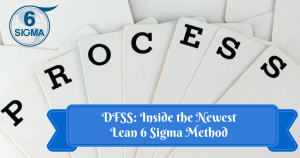
The core of a traditional Lean 6 Sigma project is the data-driven methodology DMAIC (Define, Measure, Analyze, Improve, Control). It is an excellent way to take a process that is broken or underperforming and fix it. But what happens when an entirely new process is required? How do Lean 6 Sigma and DMAIC apply when a process must be designed from scratch?
The answer lies in a newer 6 Sigma methodology known as Design For Six Sigma (DFSS). The specific steps of DFSS can vary quite a bit, depending on the company, consultant or training group using it. In this article, we will help you better understand how DFSS differs from other methodologies, and discuss three of the most popular sets of steps to perform DFSS.
How is 6 Sigma DFSS Different?
DFSS is expressly intended for designing or re-designing a process from scratch. It is highly data-driven in its approach, but allows a slightly lower Sigma level (minimum 4.5) than DMAIC methodology. This lower level is acceptable since the end result is a new product or service launch.
The following table gives you an “at a glance” view of how lean 6 sigma processes DFSS and DMAIC compare to each other.
DFSS
- Used to design or re-design a process from scratch
- Phases/steps can vary widely, depending on the company, consultant, or training group
- Data-driven, analytical, and highly structured
- Goal Sigma level 4.5 or higher
- Several methodologies to choose from, based on the needs of the business or industry
DMAIC
- Used to fix and improve an existing process
- Phases/steps are well-defined and widely recognized
- Data-driven, analytical, and highly structured
- Goal Sigma level 6.0 or higher
- Single methodology with little or no variation
What Lean 6 Sigma Methodologies are Used in DFSS?
There are a number of DFSS lean 6 sigma methodologies in common use, the most popular of which are:
- DMADV – Define, Measure, Analyze, Design, Verify
- IDOV – Identify, Design, Optimize, Validate
- DCCDI – Define, Customer, Concept, Design, Implementation
Each of these methodologies may be altered or revised, usually depending on the DFSS practitioner and/or the industry in question. For the purposes of this article, however, we will focus on the three main versions listed above.
Lean 6 Sigma: DMADV
This methodology is quite popular among DFSS practitioners. It is generally considered one of the closest in concept and application to DMAIC, which is probably why it is so often used by those who are already comfortable with that traditional lean 6 sigma method.
The specific steps of DMADV are as follows:
- Define: In this first phase, the project goals are defined. Strong consideration is given to the needs of internal as well as external customers, with the boundaries of the yet-to-be designed process clearly outlined. It should be noted that these boundaries should be firm and well defined, but they may be adjusted later if necessary as the new process unfolds and becomes clearer.
- Measure: This phase is at the core of every 6 Sigma project, and the DMADV methodology is no exception. In some cases, gathering the necessary data will be a bit easier because the affected customers (internal and external) are not already vested in an established process and they are more willing to be open and honest about their real needs. In other cases, however, the necessary data is more difficult to gather, especially if the new process is one that will supplant another well established process.
- Analyze: In this phase, the project team carefully considers the data and various options for the new process, with the focus on determining which option(s) best meet customer needs. It is extremely important to remember that there are two sets of customers to consider – internal and external.
- Design: With information from the first three phases sell understood, the project team moves on to actually designing the process. The process must be written and described in specific detail, again paying attention to the needs of both internal and external customers.
- Verify: In this final phase, the newly designed lean 6 sigma process is tested thoroughly to ensure the actual performance meets the project goals and meets the needs of internal and external customers. Tests are performed in small, controlled experiments before a full-scale launch.
DMADV
Define
- project goals
- project boundaries
- needs of internal and external customers
Measure
- data driven
- internal and external sources
Analyze
- statistical analysis
- process options
- best fit for internal and external customer needs
Design
- design the process
- detailed information and specifics
- appropriate to customer needs
Verify
- test for performance
- test for customer needs
- controlled experiments prior to full scale launch
Lean 6 Sigma: IDOV
This lean 6 sigma methodology has a strong following in the manufacturing industry. Its four phases may seem at first glance to be less comprehensive than the five phases of other methodologies, but when used properly that is not the case.
The specific steps of IDOV are as follows:
- Identify: In this first step, the project team must clearly identify the intended customer(s) for the new process. Detailed specifications are collected and used to determine the characteristics of the process that are critical to quality (CTQ).
- Design: This step uses the CTQs as key information for listing functional requirements for the process under development. The requirements are then used to create several potential processes, which are evaluated and narrowed down based on one or more selection processes.
- Optimize: This step is highly data driven, as is expected in any Six Sigma project. Statistical tools, modeling, simulations and controlled testing are employed to ensure the process design will achieve optimal performance.
- Validate: In this final step, the project team thoroughly validates the designed process, going back to the CTQs identified in the first step to ensure they will all be met.
IDOV
Identify
- intended customers
- specifications
- CTQs
Design
- use CTQs to determine functional requirements
- create process options
- evaluate options
- select best option
Optimize
- data-driven
- statistical analysis
- modeling and simulations
- maximize performance
Validate
- test for CTQs
- ensure compliance
Lean 6 Sigma: DCCDI
This methodology is growing in popularity across multiple industries. Despite the different letters in the acronym, many practitioners find DCCDI to be similar in practice to DMADV. There are enough difference between the two, however, for DCCDI to stand on its own as a distinct lean 6 Sigma methodology.
The specific steps of DCCDI are as follows:
- Define: This first step is where the goals of the DFSS project are identified and delineated clearly. This is important, as it lays the foundation for subsequent steps in the methodology.
- Customer: This step involves detailed analysis of customers and their specifications for the end product of the process to be designed. The analysis should include both internal and external customers.
- Concept: In this step, the first concepts of the new process are developed. There are generally several concepts to start with that are then narrowed down through detailed reviews and various selection processes.
- Design: This step takes the process design that emerges from the previous step and subjects it to rigorous testing to ensure it meets the needs of all customers. It must conform to required business specifications as well.
- Implementation: This final step takes the newly developed process and brings it to full scale use. The specific method(s) used in implementation will vary depending on the process, the industry and the organization.
DCCDI
Define
- project goals
Customer
- analyze specifications
- internal and external
Concept
- initial process designs
- detailed reviews
- selection process
Design
- test for performance
- test for customer specifications
- test for business specifications
Implementation
- scale up from test levels
- launch and implement
Learn more information about 6Sigma.com’s Lean Six Sigma training coursework, available as classroom, onsite, or online options.









Comments are disabled for this post.